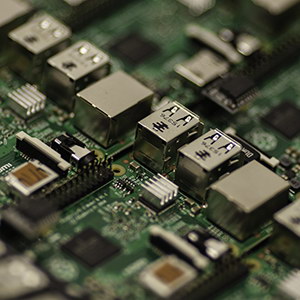How the Internet of Things Works
Lots of people really want to have smart homes, where gadgets and devices do everything for us. You know that as soon as your alarm clock goes off, you already have a hot cup of morning coffee waiting for you. You have a voice of your house, which responds to your tasks and shows you the news and composes your feed, reports everything that happens in the house etc. Your car can drive you to work without your direct participation and chooses the fastest and most optimal way to do so. The lights automatically turn on when you are in the room.
For a long time, this concept was on the pages of sci-fi books. It was some sort of futuristic model, but it is no longer so. The mechanism of devices’ interaction mentioned above is now real and possible for everyday use – it is called the Internet of things (IoT).
 The Internet of Things is composed of all the web-driven devices that pick, analyze, and send all the information they get from around the world by the means of sensors, software, and connected hardware. The devices in the IoT are connected and can ‘communicate’ with each other, interchanging information and upgrading each other. It is called M2M communication (machine to machine). People can also interact with devices and adjust them, provide needed changes, extract information, but most of the time, devices interact only on M2M level, independently from people. This is possible nowadays due to different mobile gadgets that can work synchronically in the online world of home or office.
The Internet of Things is composed of all the web-driven devices that pick, analyze, and send all the information they get from around the world by the means of sensors, software, and connected hardware. The devices in the IoT are connected and can ‘communicate’ with each other, interchanging information and upgrading each other. It is called M2M communication (machine to machine). People can also interact with devices and adjust them, provide needed changes, extract information, but most of the time, devices interact only on M2M level, independently from people. This is possible nowadays due to different mobile gadgets that can work synchronically in the online world of home or office.
The interaction of devices produces tons of internet traffic. All this data makes the surrounding world more comfortable and easy for people. However, the emergence of new data in such related manner causes problems with safety and privacy.
Despite the possible risks, the IoT opens great opportunities and brings reality to a brand-new level. The information we can have now is amazing: watching your home and family from a distance, optimization of the business processes to minimize downtime. It is possible to know which road is better to take according to the traffic density. People will know when to fix every system in the house or city, because sensors will identify the premises of damage ahead. Devices in the atmosphere can collect information in a more integral way, showing us the data on environment and its condition, as well as potential dangers. Such gadgets can be placed anywhere, which opens enormous possibilities to increase the quality of almost everything.
Kevin Ashton was the one to come up with the name 'Internet of Things' in 1999. It was a title of his presentation at Proctor & Gamble. He thought it would be nice to put a RFID tag on every lipstick and make them communicate with the radio on the shelf to signal if a new one will be needed soon. He developed the IoT from this idea, and it can cope with lots of problems.
 IoT connects an enormous number of different devices with special hardware and software that collects the information and transfers or receives it through different communication protocols. These devices may connect to your smartphone to get Internet access, or any other device at home can become a way to connect to the Internet. Some devices connect directly through the home Internet service. They use cloud-based technologies to store, classify, and analyze data. People can reach the collected or needed information through browsers, apps, or PCs. You can even manage your social networks through IoT if you set it up.
IoT connects an enormous number of different devices with special hardware and software that collects the information and transfers or receives it through different communication protocols. These devices may connect to your smartphone to get Internet access, or any other device at home can become a way to connect to the Internet. Some devices connect directly through the home Internet service. They use cloud-based technologies to store, classify, and analyze data. People can reach the collected or needed information through browsers, apps, or PCs. You can even manage your social networks through IoT if you set it up.
You may think this concept to be distant from the reality, as we don’t have houses filled with interactive systems, but this is getting closer to reality in your house every day. The research has been done, and general estimations show there are approximately 15 to 25 billion interrelated devices, and the tendency increases, making it 50 to 210 billion by 2020. Other estimations tell that, by 2025, over a trillion devices will be connected.
Numbers like these sound unbelievable, but when you imagine that sensor device is tiny and can be put at any place, these numbers will seem more realistic to you. You may not even think of your smartphone now as a device that is a small model of the IoT, but it is: a smartphone serves as an access point and can be synchronized with lots of other gadgets. Small sensors can be placed to track and analyze any object. Fitness trackers with their sensors are very popular nowadays. Built-in sensors, processors, and trackers are commonly added to almost everything from smart refrigerators to TVs. Lots of technology has such devices to make your life simpler and safer, like smart thermostats, smoke alarms, security systems, and different body trackers. They assist you in household duties, in different reminders, in home security by sending videos and warning messages from home, and even tracking your health. Nowadays, it is common and accessible to buy button-sized GPS trackers and attach them to keys, pets, phones, and other personal stuff.
These are only the devices that enter our mind first; there are more of them already on the shelves or being tested in companies. All these devices connect with people and track a person’s information, but each works independently and are not integrated. More companies today are working on the solutions to find out how to make these devices work together, to be easier to cooperate, to cut the security issues, to find a suitable platform, and to make this cooperation smooth. Lots of companies develop IoT, as it can be used not only in houses, but outside for city infrastructures and technologies that will improve well-being and quality of life.
As soon as it is possible to make different devices of different origin cooperate with one another, there will be possibilities of automation of routine tasks and making our life more organized and simplified. Nowadays, lots of objects have computing power and sensors. They analyze the world around us or our physical condition and adjust to the changes in the data provided; they cooperate with other devices to adjust to new data and integrate it for our usage. Most of these devices perform due to complicated algorithms, while in the past, only trivial if-then directions were available on their own processors or involving cloud technologies. The technology evolves rapidly, and in a few years or even months, we will consider things we cannot even comprehend yet.
The Technology to Run the Internet of Things
IoT – Possible Technical Problems and How to Overcome them
Internet of Things that Can Work with IoT
IoT – Safety and Confidentiality Issues
Financial Influence of the IoT
Summary on the IoT